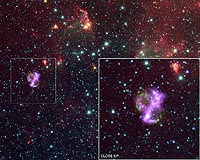 |
Paris, France (ESA) Jun 18, 2009 An enormous eruption has found its way to Earth after travelling for many thousands of years across space. Studying this blast with ESA's XMM-Newton and Integral space observatories, astronomers have discovered a dead star belonging to a rare group: the magnetars. X-Rays from the giant outburst arrived on Earth on 22 August 2008, and triggered an automatic sensor on the NASA-led, international Swift satellite. Just twelve hours later, XMM-Newton zeroed in and began to collect the radiation, allowing the most detailed spectral study of the decay of a magnetar outburst. The outburst lasted for more than four months, during which time hundreds of smaller bursts were measured. Nanda Rea from the University of Amsterdam led the team that performed the research. "Magnetars allow us to study extreme matter conditions that cannot be reproduced on Earth," she says. Magnetars are the most intensely magnetised objects in the Universe. Their magnetic fields are some 10 000 million times stronger than Earth's. If a magnetar were to magically appear at half the Moon's distance from Earth, its magnetic field would wipe the details off every credit card on Earth. This particular magnetar, known as SGR 0501+4516, is estimated to lie about 15 000 light-years away, and was undiscovered until its outburst gave it away. An outburst takes place when the unstable configuration of the magnetic field pulls the magnetar's crust, allowing matter to spew outwards in an exotic volcanic eruption. This matter tangles with the magnetic field which itself can change its configuration, releasing more energy. And this was where Integral came in. Only five days after the big eruption, Integral detected highly energetic X-rays coming from the outburst, beyond the energy range that XMM-Newton can see. It is the first time such transient X-ray emission has been detected during the outburst. It disappeared within 10 days and was probably generated as the magnetic configuration changed. Magnetar outbursts can supply as much energy to Earth as solar flares, despite the fact they are far across our Galaxy, whereas the Sun is at our celestial doorstep. There are two ideas as to how a magnetar forms. One is that it is the tiny core left behind after a highly magnetic star has died. But such magnetic stars are very rare, with just a few known in our Galaxy. Another suggestion is that during the death of a normal star, its tiny core is accelerated, providing a dynamo that strengthens its magnetic field, turning it into a magnetar. Currently most astronomers favour the first idea but as yet they have no conclusive proof. "If we could just find a magnetar in a cluster of highly magnetic stars, that would prove it," says Rea. So far only 15 magnetars in total are known in our Galaxy. SGR 0501+4516 is the first new soft gamma repeater, one of the two types of magnetars, discovered after a decade of searches. So, astronomers continue to search for more, waiting for the next giant eruption. As for their newly discovered SGR 0501+4516, the team has been granted time to return and observe it again next year with XMM-Newton. Now they know where to look, they hope to detect the object in a quiescent state, rather than in outburst, so that they can study the calm after a big storm. Share This Article With Planet Earth
Related Links the missing link Stellar Chemistry, The Universe And All Within It
 Supernova Remnant Is An Unusual Suspect
Supernova Remnant Is An Unusual SuspectBoston MA (SPX) Jun 12, 2009 A new image from NASA's Chandra X-ray Observatory shows a supernova remnant with a different look. This object, known as SNR 0104-72.3 (SNR 0104 for short), is in the Small Magellanic Cloud, a small neighboring galaxy to the Milky Way. Astronomers think that SNR 0104 is the remains of a so-called Type Ia supernova caused by the thermonuclear explosion of a white dwarf. In this composite ... read more |
|
| The content herein, unless otherwise known to be public domain, are Copyright 1995-2009 - SpaceDaily. AFP and UPI Wire Stories are copyright Agence France-Presse and United Press International. ESA Portal Reports are copyright European Space Agency. All NASA sourced material is public domain. Additional copyrights may apply in whole or part to other bona fide parties. Advertising does not imply endorsement,agreement or approval of any opinions, statements or information provided by SpaceDaily on any Web page published or hosted by SpaceDaily. Privacy Statement |